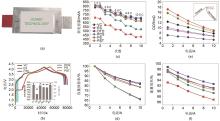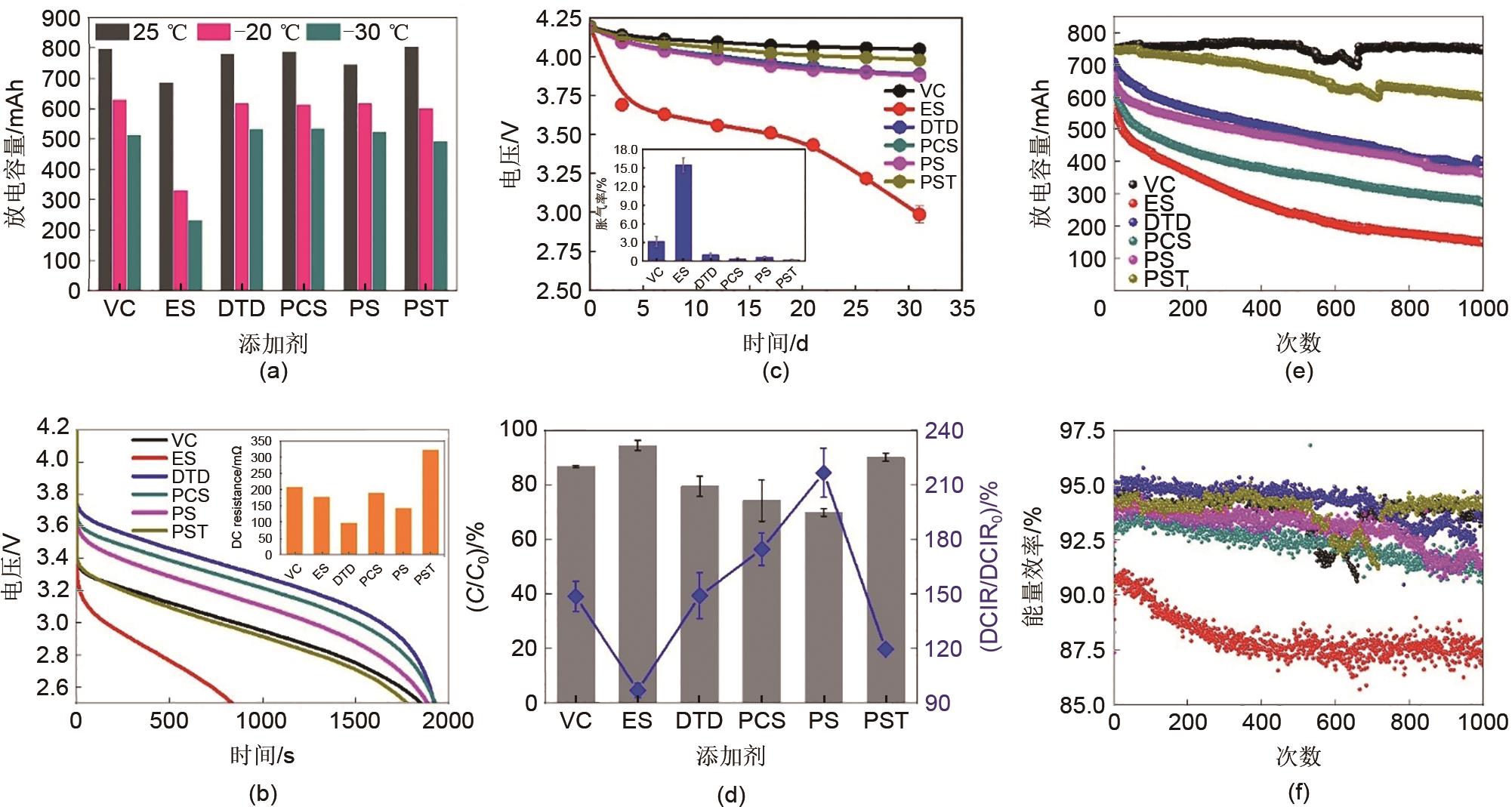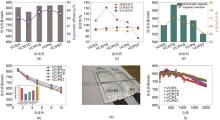Energy Storage Science and Technology ›› 2023, Vol. 12 ›› Issue (8): 2390-2400.doi: 10.19799/j.cnki.2095-4239.2023.0250
• Energy Storage Materials and Devices • Previous Articles Next Articles
Hengheng XIA( ), Pengcheng LIANG, Zhongxun AN(
), Pengcheng LIANG, Zhongxun AN( )
)
Received:2023-04-19
Revised:2023-05-03
Online:2023-08-05
Published:2023-08-23
Contact:
Zhongxun AN
E-mail:xia_hheng@163.com;an_zhongxun@aowei.com
CLC Number:
Hengheng XIA, Pengcheng LIANG, Zhongxun AN. Effects of sulfur-containing electrolyte additives on the performance of lithium nickel cobalt manganese oxide//graphite Li-ion batteries[J]. Energy Storage Science and Technology, 2023, 12(8): 2390-2400.
Table 1
Physical and chemical qualities of various electrolyte additives"
| 电解液添加剂 | 还原电位(vs. Li/Li+)/V | LUMO/eV | 熔点/℃ |
|---|---|---|---|
| 碳酸亚乙烯酯(VC) | 0.9 (1.0 mol/L LiPF6-VC/DEC)[ | -0.01[ | 22 |
| 亚硫酸乙烯酯(ES) | 1.7 (1.0 mol/L LiPF6-EC/DMC)[ | -1.25[ | -17 |
| 硫酸乙烯酯(DTD) | 1.25 (1.0 mol/L LiPF6-EC/DMC/EMC)[ | 0.11[ | 99 |
| 1,3-丙二醇环硫酸酯(PCS) | 1.8 (1.0 mol/L LiPF6-EC/DEC)[ | -0.34[ | 60 |
| 1,3-丙烷磺酸内酯(PS) | 0.74 (1.0 mol/L LiPF6-EC/DMC)[ | 0.03[ | 30 |
| 1,3-丙烯磺酸内酯(PST) | 1.12 (1.0 mol/L LiPF6-EC/DMC)[ | -0.27[ | 83 |

Fig. 2
Performance of NCM//G Li-ion batteries with different single electrolyte additive: (a) Cell physical appearance; (b) First charging-discharging curve, Coulombic efficiency and discharged capacity; (c) Discharged capacity, (d) Capacity retention, (e) DC resistance, and (f) Energy efficiency at various rate currents"


Fig. 3
Performance of NCM//G Li-ion batteries with various single-component electrolyte additive: (a) Discharged capacity at different temperatures; (b) Discharging curves and initial DCR (illustrated) at -30 ℃; (c) OCV variation curves and cell flatulence rates before and after high-temperature storage (illustrated); (d) Capacity retention and DCR variation before and after high-temperature storage; (e) Discharged capacity and (f) Energy efficiency during the cycles at 5 C (2.8–4.2 V)"


Fig. 5
Performance of mixed additives with sulfur-containing additives and VC in a 1/1 mass ratio: (a) First coulombic efficiency (ICE) and discharged capacity (IDC); (b) Discharged capacity and DCR at different currents; (c) Capacity retention, DCR change and OCV retention before and after high temperature storage; (d) Cell flatulence images of ES and VC/ES additives after 1000 cycles; (e) Discharged capacity and capacity retention at -30 ℃ ambient temperature; (f) Cycle performance at the rate of 5 C"

| 1 | 索鎏敏, 李泓. 锂离子电池过往与未来[J]. 物理, 2020, 49(1): 17-23. |
| SUO L M, LI H. The past, present and future of lithium ion batteries[J]. Physics, 2020, 49(1): 17-23. | |
| 2 | 封迈, 陈楠, 陈人杰. 锂离子电池低温电解液的研究进展[J]. 储能科学与技术, 2023, 12(3): 792-807. |
| FENG M, CHEN N, CHEN R J. Research progress of low-temperature electrolyte for lithium-ion battery[J]. Energy Storage Science and Technology, 2023, 12(3): 792-807. | |
| 3 | 倪江锋, 周恒辉, 陈继涛, 等. 锂离子电池中固体电解质界面膜(SEI)研究进展[J]. 化学进展, 2004, 16(3): 335-342. |
| NI J F, ZHOU H H, CHEN J T, et al. Progress in solid electrolyte interface in lithium ion batteries[J]. Progress in Chemistry, 2004, 16(3): 335-342. | |
| 4 | ZHAO D N, WANG P, CUI X L, et al. Robust and sulfur-containing ingredient surface film to improve the electrochemical performance of LiDFOB-based high-voltage electrolyte[J]. Electrochimica Acta, 2018, 260: 536-548. |
| 5 | XU M Q, LI W S, ZUO X X, et al. Performance improvement of lithium ion battery using PC as a solvent component and BS as an SEI forming additive[J]. Journal of Power Sources, 2007, 174(2): 705-710. |
| 6 | ZHANG S S. A review on electrolyte additives for lithium-ion batteries[J]. Journal of Power Sources, 2006, 162(2): 1379-1394. |
| 7 | BURNS J C, PETIBON R, NELSON K J, et al. Studies of the effect of varying vinylene carbonate (VC) content in lithium ion cells on cycling performance and cell impedance[J]. Journal of the Electrochemical Society, 2013, 160(10): A1668-A1674. |
| 8 | BURNS J C, SINHA N N, COYLE D J, et al. The impact of varying the concentration of vinylene carbonate electrolyte additive in wound Li-ion cells[J]. Journal of the Electrochemical Society, 2011, 159(2): A85-A90. |
| 9 | WU Z L, LI S G, ZHENG Y Z, et al. The roles of sulfur-containing additives and their working mechanism on the temperature-dependent performances of Li-ion batteries[J]. Journal of the Electrochemical Society, 2018, 165(11): A2792-A2800. |
| 10 | 周丹, 梁风, 姚耀春. 锂离子电池电解液负极成膜添加剂的研究进展[J]. 化工进展, 2016, 35(5): 1477-1483. |
| ZHOU D, LIANG F, YAO Y C. Research progress of negative film-forming additives in electrolyte for Li-ion batteries[J]. Chemical Industry and Engineering Progress, 2016, 35(5): 1477-1483. | |
| 11 | 张晓妍, 任宇飞, 高洁, 等. 动力电池电解液用添加剂的研究进展[J]. 储能科学与技术, 2018, 7(3): 404-417. |
| ZHANG X Y, REN Y F, GAO J, et al. Progress of electrolyte additives for high-capacity power lithium ion batteries[J]. Energy Storage Science and Technology, 2018, 7(3): 404-417. | |
| 12 | XIA J, AIKEN C P, MA L, et al. Combinations of ethylene sulfite (ES) and vinylene carbonate (VC) as electrolyte additives in Li(Ni1/3Mn1/3Co1/3)O2/graphite pouch cells[J]. Journal of the Electrochemical Society, 2014, 161(6): A1149-A1157. |
| 13 | 邓邦为, 孙大明, 万琦, 等. 锂离子电池三元正极材料电解液添加剂的研究进展[J]. 化学学报, 2018, 76(4): 259-277. |
| DENG B W, SUN D M, WAN Q, et al. Review of electrolyte additives for ternary cathode lithium-ion battery[J]. Acta Chimica Sinica, 2018, 76(4): 259-277. | |
| 14 | REN F C, ZUO W H, YANG X R, et al. Comprehensive understanding of reduction mechanisms of ethylene sulfite in EC-based lithium-ion batteries[J]. The Journal of Physical Chemistry C, 2019, 123(10): 5871-5880. |
| 15 | PARK G, NAKAMURA H, LEE Y, et al. The important role of additives for improved lithium ion battery safety[J]. Journal of Power Sources, 2009, 189(1): 602-606. |
| 16 | WRODNIGG G H, BESENHARD J O, WINTER M. Cyclic and acyclic sulfites: New solvents and electrolyte additives for lithium ion batteries with graphitic anodes?[J]. Journal of Power Sources, 2001, 97: 592-594. |
| 17 | 陈高明, 胡立新, 王超. 锂离子电池电解液添加剂的研究进展[J]. 能源研究与管理, 2011(2): 57-61. |
| CHEN G M, HU L X, WANG C. Research progress of additives for Li-ion battery electrolytes[J]. Energy Research and Management, 2011(2): 57-61. | |
| 18 | 周密, 王希敏, 袁银男, 等. 电解液添加剂对高镍锂离子电池性能的影响[J]. 电池, 2022, 52(3): 237-242. |
| ZHOU M, WANG X M, YUAN Y N, et al. Effect of electrolyte additives on the performance of high nickel Li-ion battery[J]. Battery Bimonthly, 2022, 52(3): 237-242. | |
| 19 | SELF J, HALL D S, MADEC L, et al. The role of prop-1-ene-1,3-sultone as an additive in lithium-ion cells[J]. Journal of Power Sources, 2015, 298: 369-378. |
| 20 | XU G J, PANG C G, CHEN B B, et al. Batteries: Prescribing functional additives for treating the poor performances of high-voltage (5 V-class) LiNi0.5Mn1.5O4/MCMB Li-ion batteries[J]. Advanced Energy Materials, 2018, 8(9): 1870038. |
| 21 | FUJIMOTO M, SHOUJI Y, NOHMA T, et al. Charge-discharge characteristics of natural graphite electrode in some cyclic carbonates[J]. Denki Kagaku Oyobi Kogyo Butsuri Kagaku, 1997, 65(11): 949-953. |
| 22 | MOSALLANEJAD B. Phthalimide derivatives: New promising additives for functional electrolyte in lithium-ion batteries[J]. Chemical Methodologies, 2019, doi: 10.22034/chemm.2018. 155768.1109. |
| 23 | XING L D, LI W S, XU M Q, et al. The reductive mechanism of ethylene sulfite as solid electrolyte interphase film-forming additive for lithium ion battery[J]. Journal of Power Sources, 2011, 196(16): 7044-7047. |
| 24 | LI X C, YIN Z L, LI X H, et al. Ethylene sulfate as film formation additive to improve the compatibility of graphite electrode for lithium-ion battery[J]. Ionics, 2014, 20(6): 795-801. |
| 25 | FELIX, CHENG J H, HY S, et al. Mechanistic basis of enhanced capacity retention found with novel sulfate-based additive in high-voltage Li-ion batteries[J]. The Journal of Physical Chemistry C, 2013, 117(44): 22619-22626. |
| 26 | JANKOWSKI P, LINDAHL N, WEIDOW J, et al. Impact of sulfur-containing additives on lithium-ion battery performance: From computational predictions to full-cell assessments[J]. ACS Applied Energy Materials, 2018, 1(6): 2582-2591. |
| 27 | 杜强, 张一鸣, 田爽, 等. 锂离子电池SEI膜形成机理及化成工艺影响[J]. 电源技术, 2018, 42(12): 1922-1926. |
| DU Q, ZHANG Y M, TIAN S, et al. Formation mechanism of solid electrolyte interphase (SEI) and effect of formation process on it in lithium ion batteries[J]. Chinese Journal of Power Sources, 2018, 42(12): 1922-1926. | |
| 28 | XU Y B, WU H P, HE Y, et al. Atomic to nanoscale origin of vinylene carbonate enhanced cycling stability of lithium metal anode revealed by cryo-transmission electron microscopy[J]. Nano Letters, 2020, 20(1): 418-425. |
| 29 | ITAGAKI M, YOTSUDA S, KOBARI N, et al. Electrochemical impedance of electrolyte/electrode interfaces of lithium-ion rechargeable batteries: Effects of additives to the electrolyte on negative electrode[J]. Electrochimica Acta, 2006, 51(8/9): 1629-1635. |
| 30 | 周邵云, 洪坤光, 余乐, 等. 1-丙烯-1,3-磺酸内酯对高电压锂离子电池的影响[J]. 电池, 2016, 46(4): 189-192. |
| ZHOU S Y, HONG K G, YU L, et al. Effect of 1-propenyl-1,3-sultones on high-voltage Li-ion battery[J]. Battery Bimonthly, 2016, 46(4): 189-192. | |
| 31 | TONG B, SONG Z Y, WAN H H, et al. Sulfur-containing compounds as electrolyte additives for lithium-ion batteries[J]. InfoMat, 2021, 3(12): 1364-1392. |
| 32 | MADEC L, PETIBON R, XIA J, et al. Understanding the role of prop-1-ene-1,3-sultone and vinylene carbonate in LiNi1/3Mn1/3Co1/3O2/graphite pouch cells: Electrochemical, GC-MS and XPS analysis[J]. Journal of the Electrochemical Society, 2015, 162(14): A2635-A2645. |
| 33 | ZHANG B, METZGER M, SOLCHENBACH S, et al. Role of 1, 3-propane sultone and vinylene carbonate in solid electrolyte interface formation and gas generation[J]. The Journal of Physical Chemistry C, 2015, 119(21): 11337-11348. |
| 34 | LIU Y L, HAMAM I, DAHN J R. A study of vinylene carbonate and prop-1-ene-1,3 sultone electrolyte additives using polycrystalline Li[Ni0.6Mn0.2Co0.2]O2 in positive/positive symmetric cells[J]. Journal of the Electrochemical Society, 2020, 167(11): 110527. |
| 35 | JANSSEN P, SCHMITZ R, MÜLLER R, et al. 1,3,2-Dioxathiolane-2,2-dioxide as film-forming agent for propylene carbonate based electrolytes for lithium-ion batteries[J]. Electrochimica Acta, 2014, 125: 101-106. |
| 36 | LEE H, CHOI S, CHOI S, et al. SEI layer-forming additives for LiNi0.5Mn1.5O4/graphite 5 V Li-ion batteries[J]. Electrochemistry Communications, 2007, 9(4): 801-806. |
| 37 | KOREPP C, SANTNER H J, FUJII T, et al. 2-Cyanofuran—A novel vinylene electrolyte additive for PC-based electrolytes in lithium-ion batteries[J]. Journal of Power Sources, 2006, 158(1): 578-582. |
| 38 | PRITZL D, SOLCHENBACH S, WETJEN M, et al. Analysis of vinylene carbonate (VC) as additive in graphite/LiNi0.5Mn1.5O4 cells[J]. Journal of the Electrochemical Society, 2017, 164(12): A2625-A2635. |
| 39 | CHENG H R, SUN Q J, LI L L, et al. Emerging era of electrolyte solvation structure and interfacial model in batteries[J]. ACS Energy Letters, 2022, 7(1): 490-513. |
| 40 | XIA J, HARLOW J E, PETIBON R, et al. Comparative study on methylene methyl disulfonate (MMDS) and 1,3-propane sultone (PS) as electrolyte additives for Li-ion batteries[J]. Journal of the Electrochemical Society, 2014, 161(4): A547-A553. |
| [1] | Cong LI, Tao WANG, Yanjie REN, Libo ZHOU, Jian CHEN, Wei CHEN. Cathodic dissolution and protection of molten carbonate fuel cells [J]. Energy Storage Science and Technology, 2023, 12(8): 2444-2456. |
| [2] | Zhengguang ZHAO, Zhenying CHEN, Guangqun ZHAI, Xi ZHANG, Xiaodong ZHUANG. Preparation of Sc/O-doped sulfide electrolyte for all-solid-state batteries [J]. Energy Storage Science and Technology, 2023, 12(8): 2412-2423. |
| [3] | Huan LIU, Na PENG, Qingwen GAO, Wenpeng LI, Zhirong YANG, Jingtao WANG. Crown ether-doped polymer solid electrolyte for high-performance all-solid-state lithium batteries [J]. Energy Storage Science and Technology, 2023, 12(8): 2401-2411. |
| [4] | Zhihao LIU, Tong DU, Ruirui LI, Tao DENG. Developments of wide temperature range, high voltage and safe EC-free electrolytes [J]. Energy Storage Science and Technology, 2023, 12(8): 2504-2525. |
| [5] | Chong XU, Ning XU, Zhimin JIANG, Zhongkai LI, Yang HU, Hong YAN, Guoqiang MA. Mechanisms of gas evolution and suppressing strategies based on the electrolyte in lithium-ion batteries [J]. Energy Storage Science and Technology, 2023, 12(7): 2119-2133. |
| [6] | Jiayi ZHANG, Suting WENG, Zhaoxiang WANG, Xuefeng WANG. Solid electrolyte interphase (SEI) on graphite anode correlated with thermal runaway of lithium-ion batteries [J]. Energy Storage Science and Technology, 2023, 12(7): 2105-2118. |
| [7] | Guiping ZHANG, Xiaoyan YAN, Bing WANG, Peixin YAO, Changjie HU, Yizhe LIU, Shuli LI, Jianjun XUE. Long life lithium iron phosphate battery and its materials and process [J]. Energy Storage Science and Technology, 2023, 12(7): 2134-2140. |
| [8] | Qixin GAO, Jingteng ZHAO, Guoxing LI. Research progress on fast-charging lithium-ion batteries [J]. Energy Storage Science and Technology, 2023, 12(7): 2166-2184. |
| [9] | Ronghan QIAO, Jing ZHU, Xiaoyu SHEN, Guanjun CEN, Junfeng HAO, Hongxiang JI, Mengyu TIAN, Zhou JIN, Yuanjie ZHAN, Yida WU, Yong YAN, Liubin BEN, Hailong YU, Yanyan LIU, Xuejie HUANG. Reviews of selected 100 recent papers for lithium batteries (Apr. 1, 2023 to May 31, 2023) [J]. Energy Storage Science and Technology, 2023, 12(7): 2333-2348. |
| [10] | Zenghui HAO, Xunliang LIU, Yuan MENG, Nan MENG, Zhi WEN. Effect of electrode interface microstructure on the performance of solid-state lithium-ion battery [J]. Energy Storage Science and Technology, 2023, 12(7): 2095-2104. |
| [11] | Lingfeng HUANG, Dongmei HAN, Sheng HUANG, Shuanjin WANG, Min XIAO, Yuezhong MENG. Research progress of polymer electrolytes containing organoboron for lithium-ion batteries [J]. Energy Storage Science and Technology, 2023, 12(6): 1815-1830. |
| [12] | Yongli YI, Ran YU, Wu LI, Yi JIN, Zheren DAI. Preparation of Mo, Al-doped Li7La3Zr2O12-based composite solid electrolyte and performance of all-solid-state batterys [J]. Energy Storage Science and Technology, 2023, 12(5): 1490-1499. |
| [13] | Shedong LI, Yingying SONG, Yuhua BIAN, Zhaomeng LIU, Xuanwen GAO, Wenbin LUO. Status and challenges in the development of room-temperature sodium-sulfur batteries [J]. Energy Storage Science and Technology, 2023, 12(5): 1315-1331. |
| [14] | Xuanchen WANG, Da WANG, Zhaomeng LIU, Xuanwen GAO, Wenbin LUO. Research progress and prospect of potassium ion battery electrolyte [J]. Energy Storage Science and Technology, 2023, 12(5): 1409-1426. |
| [15] | Yongshi YU, Xianming XIA, Hongyang HUANG, Yu YAO, Xianhong RUI, Guobin ZHONG, Wei SU, Yan YU. Research progress on sodium metal anode modified by artificial interface layer [J]. Energy Storage Science and Technology, 2023, 12(5): 1380-1391. |
| Viewed | ||||||
|
Full text |
|
|||||
|
Abstract |
|
|||||
